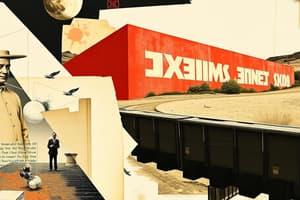Podcast
Questions and Answers
What is a defining characteristic of wikis?
What is a defining characteristic of wikis?
- They only contain static information.
- They are limited to organization use only.
- They can be collaboratively edited by their audience. (correct)
- They are solely created by professionals.
Which of the following is NOT a key feature of Web 2.0?
Which of the following is NOT a key feature of Web 2.0?
- Limited User Participation (correct)
- Rich User Interface
- Folksonomy
- Long Tail
Which of the following is an example of a video sharing site?
Which of the following is an example of a video sharing site?
- Wikimedia
- YouTube (correct)
- Wikivoyage
- Wikipedia
What does the term 'Folksonomy' refer to?
What does the term 'Folksonomy' refer to?
Which of these wikis is specifically designed for educational purposes?
Which of these wikis is specifically designed for educational purposes?
What is the primary focus of a portfolio website?
What is the primary focus of a portfolio website?
Which type of website is primarily designed for educational institutions?
Which type of website is primarily designed for educational institutions?
What distinguishes a brochure website from a full business website?
What distinguishes a brochure website from a full business website?
What is a common purpose of a nonprofit website?
What is a common purpose of a nonprofit website?
What is an infopreneur website primarily focused on?
What is an infopreneur website primarily focused on?
Flashcards are hidden until you start studying
Study Notes
Wikis
- Hypertext publications edited collaboratively by users through web browsers.
- Typical wikis consist of multiple pages and can be public or restricted to organizations.
- Examples include Wikipedia, Wikivoyage, Wikibooks, Wikidata, Wikiversity, Wikinews, Wikimedia Commons, Wikispecies, Wiktionary, MediaWiki, and Wikiquote.
Video Sharing Sites
- Websites that allow users to upload and share video clips with the public or a selected audience.
- Notable platforms include YouTube, Photobucket, Facebook, Twitter, LinkedIn, Veoh, Flickr, Dailymotion, VimeoPRO, Myspace.com, and Metacafe.
Key Features of Web 2.0
- Folksonomy: Users categorize and tag information freely to organize content.
- Rich User Interface: Dynamic content that responds to user inputs.
- User Participation: Variety of users contribute content through comments, reviews, and ratings.
- Long Tail: Services offered on demand, allowing for simpler portfolio-based websites showcasing samples of past work.
Types of Websites
- Media Website: Collects news stories and reported pieces.
- Brochure Website: Simplified business site outlining services and contact information.
- Nonprofit Website: Essential for fundraising and information dissemination for nonprofits.
- Educational Website: Provides educational materials and institutional information.
- Infopreneur Website: Focuses on selling information products such as courses and eBooks.
- Personal Website: Blogs, vlogs, and photo diaries for individual expression.
- Web Portal: Internal websites aggregating information for organizational users, often requiring login for personalized access.
- Wiki or Community Forum Website: Collaboratively created sites on diverse subjects.
Internet Overview
- The Internet is the biggest computer network globally, connecting billions of users through interlinked devices.
- The term combines "interconnection" and "network," emphasizing decentralized ownership and resilience.
Brief History of the Internet
- ARPA: Experimental network launched on January 2, 1969, fostering equal participation among nodes.
- 1982: The term "internet" emerged.
- 1986: Case Western Reserve University's "free net" created.
- 1991: US government allowed business agencies to connect, broadening access.
Major Components of the Internet
-
Servers: Programs providing services to other programs or devices.
- Types include Application, Web, Proxy, Mail, File, and Policy Servers.
-
IP Address: A unique numerical label for each device on the network, providing identity.
-
Browser: Software enabling users to view and navigate online content (e.g., Google Chrome, Safari).
-
Domain Name System (DNS): Functions like an internet phonebook, converting domain names to IP addresses.
-
Internet Service Provider (ISP): Organizations facilitating access to the internet, categorized as national or regional.
Uses of the Internet
- Information retrieval for studies and personal use.
- Sending and receiving emails.
- Video teleconferencing.
- E-commerce and social networking.
- Uploading and viewing videos, online gaming, college courses, and financial transactions.
Internet Terms and Definitions
- Internet: A global arrangement of numerous interlinked computer networks.
- Web: A collection of billions of webpages accessible via web browsers.
Studying That Suits You
Use AI to generate personalized quizzes and flashcards to suit your learning preferences.





